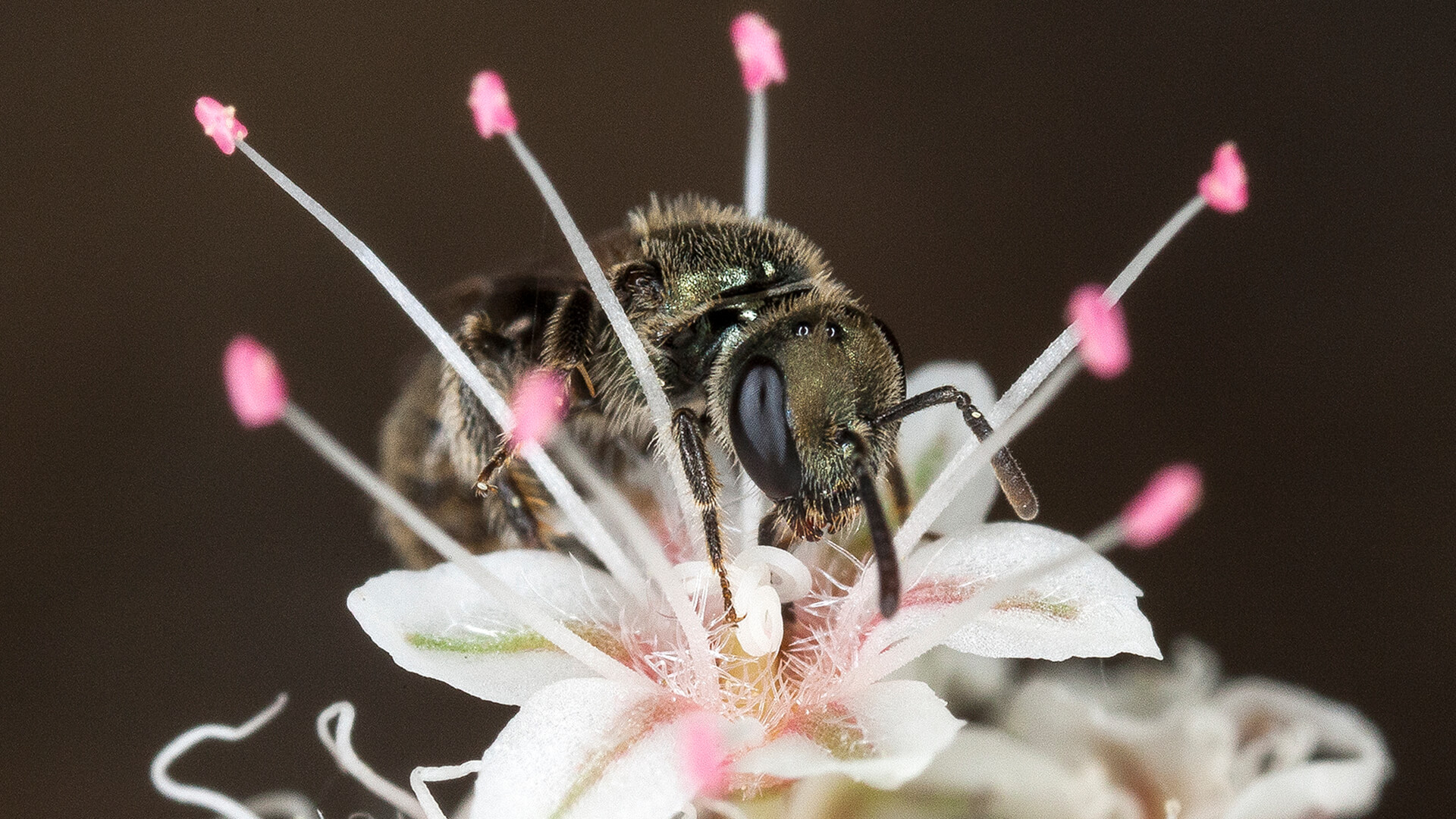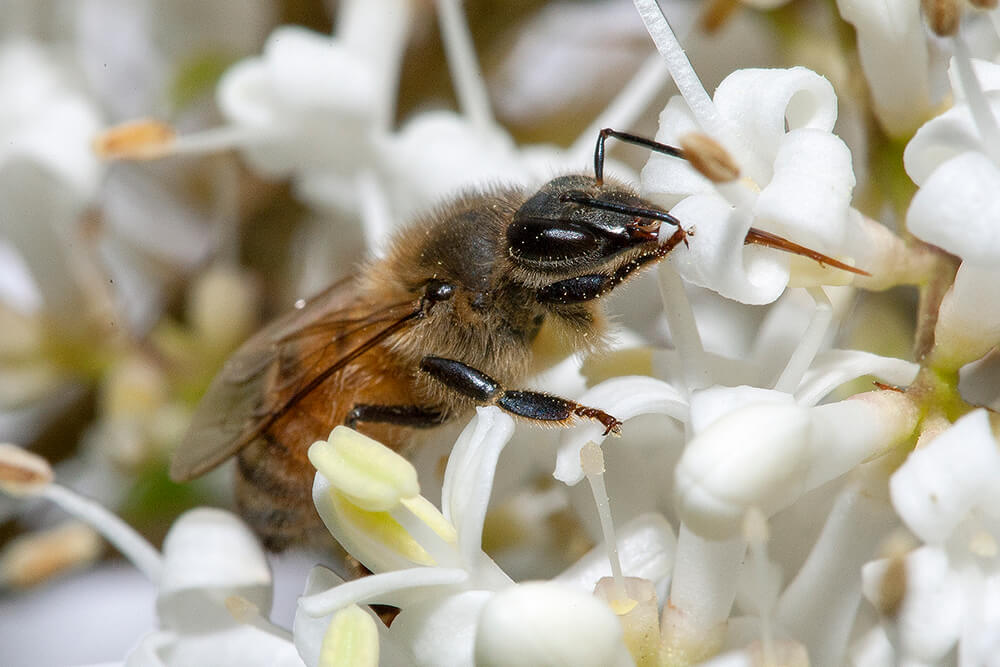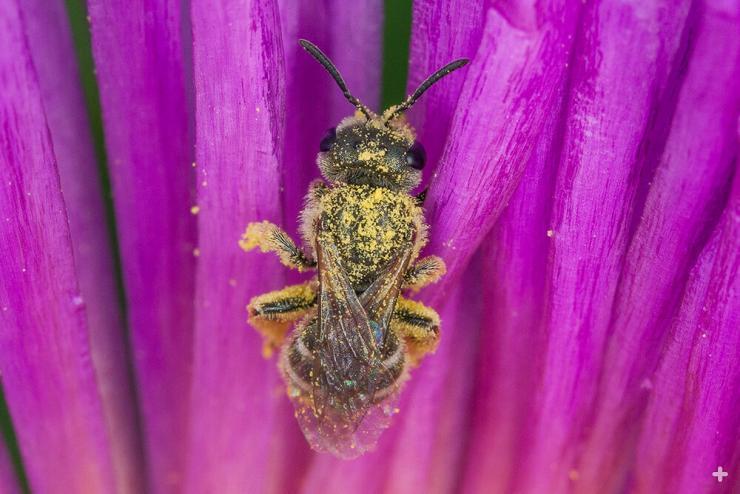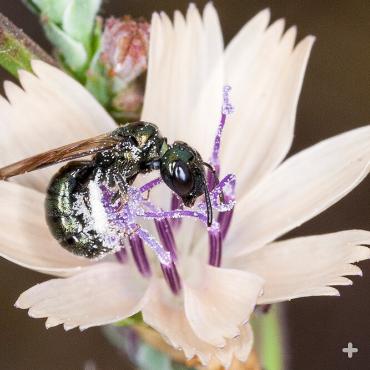
ABOUT
Sometimes you hear them before you see them. You may even be afraid of them. But the more you know about bees, the more you can appreciate these unique insects and how they provide us humans with much more than just honey!
Bees may be black, brown, or banded with white, yellow, or orange stripes. All bees are covered with hair, but some have more hair than others. They are specialized insects called pollinators that gather nectar and pollen from flowers. As pollinators, they play a very important role in ecosystems worldwide.
Cultivated or native? When we think of bees, we usually think of honeybees. They make the sweet honey we eat and the beeswax we use to make candles and other products. Honeybees are considered “cultivated bees,” as humans who want to use them for honey and beeswax production have usually brought them into an area from another part of the world.
But did you know that there are more than 4,000 types of “native bees” in the United States? Native bees are those that have always lived in an area and are able to survive without help from humans. These bees don’t make honey or beeswax that we can use, but they do pollinate many of our plants and food crops. They do this so much that they are called the “super pollinators.”
Pollen possibilities. Bees were very similar to carnivorous wasps millions of years ago. But when flowering plants appeared on Earth, bees became vegetarians, eating only nectar and pollen taken from flowers. Pollen is a well-balanced food with many of the essential nutrients bees need to survive. Female bees have a structure on their legs that no other insects, including wasps, have: a pollen basket. The basket is made of rows of stiff hairs that arch to form a hollow space on the outside of the bees’ legs, usually her back legs. When a bee visits a flower, she combs grains of pollen into her baskets. Pollen from the flower also sticks to the bee’s hair.
Male bees do not collect pollen, so they don’t have this special body part. Leafcutting bees carry pollen in a brush of hair on the underside of the abdomen. And a few species, such as parasitic bees, have no pollen basket.
What about the flower’s nectar? Bees have a special tongue that sucks up the sweet nectar and a crop in their throat for storing it until they get back to the hive. Here the nectar is turned into honey. Bees can store large amounts of the honey in their hives to use as food.
HABITAT AND DIET

All bees fly from flower to flower, sipping nectar and collecting grains of pollen. Many plants depend on bees to spread pollen, helping them to reproduce. Flowers that attract bees are usually yellow, blue, and purple. Many bees specialize in one specific type of plant. In areas where different flowering plants bloom at the same time, this keeps different bee species from fighting over the same flower!
Fruits and vegetables we like to eat, such as oranges, tomatoes, and squash, need bees to distribute the important pollen. When these crops are ready to produce their flowers, farmers often hire commercial beekeepers to deliver bees to their fields. The beekeeper places beehives near the field for a few weeks. The bees harvest pollen and nectar for their hive, and the plants get pollinated in the process.
Bees are also important in keeping food around for humans. We can thank bees for a lot of products we humans use:
Fruits and vegetables: Think of bees when you enjoy almonds, apples, avocados, blueberries, cherries, cranberries, cucumbers, kiwis, melons, peaches, pears, plums, strawberries, sunflower seeds, watermelons, and many more. These items are all the result of bee pollination!
Honey: Who doesn’t like the sweet taste of honey? Honey can have different flavors and colors, too, depending on which flowers the bees used to collect the nectar. For example, there is clover honey, orange-blossom honey, sourwood honey, and buckwheat honey.
Beeswax: Candles made from beeswax give off a honey-scented glow and burn cleanly and brightly. Beeswax is also used for hand cream, furniture polish, and candy coatings (like on jelly beans!).
It’s a bee-utiful world with bees: Bees can be both remarkable and fascinating to watch, from a distance! Give them their space, and they will go about their work assisting in flowering plant reproduction and bringing us tastier fruits and vegetables, PLUS fewer pests and a healthier habitat!
FAMILY LIFE

Most bees are solitary and don’t form hives. Each female builds her nest in holes found in dead wood, tree hollows, snail shells, or crumbling walls. Some build nests on rocks or shrubby plants, using mud, chewed leaves, and animal hairs. Eggs are laid on pollen balls in the nest. Parasitic bees lay eggs in the nests of other bees. Their larvae eat the pollen and honey intended for the host’s larvae!
Solitary bees hardly ever sting. In fact, male bees don’t even have stingers, and the females’ are not long enough to penetrate your skin. Solitary bees don’t have “back-up” like honeybees, nor a hive to defend, making them even less likely to sting. Instead of producing honey, they make a food called “beebread” by mixing pollen and nectar. Females fill their pollen baskets and carry the pollen back to the nest to make batches of beebread for their offspring.
Honeybees and bumblebees are social. They live in colonies consisting of a fertile queen, sterile female workers, and males called “drones.” These social bees are the only bees to produce and store honey.
Honeybees, bumblebees, and a few native bees live in colonies or hives. The bees all work together for the good of the hive. No honeybee or bumblebee can survive for long on its own. Each has a job to do:
The Queen: From her title, it may sound like the queen is in charge, but she really has little power in the hive. Her only job is to lay eggs—up to 2,000 per day for 2 to 5 years! The worker bees control how many eggs she lays by the amount of food they feed her.
The Workers: Most of the other bees in the hive are females, too. They are called “workers,” and with good reason! They build the honeycomb, care for the larvae, clean the hive, feed the queen, and collect the food. There are thousands of workers in a colony, sometimes up to 60,000 bees! Their jobs change as they age.
A newly hatched bee works as a cleaner for her first three days. Then the young bee acts as a nurse, feeding the larvae and queen. At about day 10, as her wax glands mature, she becomes a builder, constructing the honeycombs. From about day 16 to 20, she receives the pollen and nectar brought to the hive by the older bees and places them in the comb. For the next few days she guards the hive. Near the end of her life she becomes a food collector. She flies back and forth during her remaining weeks to get as much nectar and pollen as she can for the hive.
The Drones: These are the few males that hatch in the hive. They spend their first days after hatching being fed by their sisters before flying off to look for a queen. Drones have huge eyes to help them find a queen. Only the fastest drones catch the queens and have a chance at breeding. Once a drone catches a queen and successfully mates, he dies.
“Talking” Bees: Worker bees tell others in the colony about a new food source by marking a scent trail between it and the nest. Honeybees share this information by “dancing.” The bee that has found the new patch of flowers takes a pollen sample back to the colony, where she shakes and wiggles her tail, spreading the flower scent to the others. Some scientists believe the way she moves tells the others what direction the food is in. Others believe that she’s just shaking off the scent so the other bees know which scent to search for. Either way, the bee gets her message across, and soon other bees are hot on the trail of tasty nectar.
Inside a hive hang sheets of honeycomb made by the bees to protect their larvae and store their collection of pollen and honey. The honeycomb is made from beeswax secreted by glands on the worker bees’ abdomens. The workers chew the wax and mold it into 6-sided honeycomb cells that together form a sheet of honeycomb from 2 to 4 feet (0.6 to 1.2 meters) long. An empty honeycomb weighs just a few ounces (grams), but when full of honey it can weigh many pounds (kilograms).
Killer bees: There’s been a lot of hype about so-called killer bees, starting with that scary name. The correct name is Africanized honeybee (AHB). In 1956, African honeybees were brought to Brazil and cross-bred with local honeybees to create hybrid bees to increase honey production. Unfortunately, these new hybrids turned out to be very aggressive. This was not a desirable situation for the beekeepers! Several AHB queens escaped from Brazil, and AHBs have gradually spread northward through South America, Central America, eastern Mexico, and now the United States.
AHBs look exactly like regular honeybees, but they act a bit differently; they are more fierce and quick at defending their hives. These bees chase their enemies for longer distances, and they tend to gang up, stinging in large numbers. When a person is stung many times, that could be dangerous. But a single sting from one AHB is no more dangerous than any other bee sting.
CONSERVATION
You may have heard of Colony Collapse Disorder (CCD), the rapid loss of entire honeybee colonies. A dramatic decline in these pollinators could severely hurt our food supplies. The reasons for the decline are still unclear, but it is believed that the use of pesticides, the types of crops we grow, disease from mites and fungus, and the stress of moving hives long distances for farming might all be damaging honeybee populations. It seems that beekeepers raising bees with organic methods and keeping them in permanent bee apiaries are not having as much trouble.
Luckily, CCD has not affected native solitary bees. This is good news for us. If honeybees were ever to no longer meet our pollination needs, native bees could be raised to supplement or replace them. Studies have shown it would only take 500 blue orchard bees to do the job of 40,000 honeybees! Many more questions need to be answered and research is ongoing, but it’s nice to know that the native bees we tend to take for granted might one day play an even bigger role in our survival.
What can you do for bees? Try to avoid using pesticides. Plant diverse, native plants in your garden. Provide bee nesting and egg-laying sites. Provide sheltered, undisturbed areas where native bees can hibernate or overwinter. No yard or garden? No problem—you can still be part of the solution by installing an inexpensive “bee block” for solitary bees to nest in.







